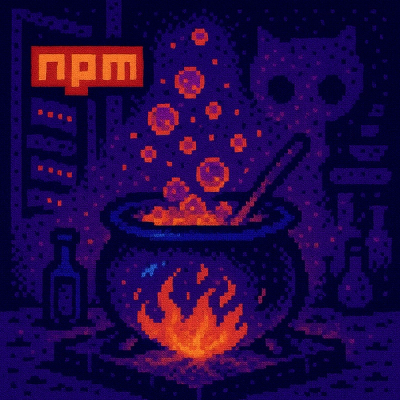
Research
/Security News
9 Malicious NuGet Packages Deliver Time-Delayed Destructive Payloads
Socket researchers discovered nine malicious NuGet packages that use time-delayed payloads to crash applications and corrupt industrial control systems.
@remkoj/optimizely-cms-react
Advanced tools
[!WARNING] This documentation is for V3 and up. This version introduced a number of breaking changes - most notably it significantly simplified the exports.
For some of the commonly used old exports it still contains placeholders, however those are deprecated and will be removed in a future version
This package provides two main entry points, depending on your build environment:
@remkoj/optimizely-cms-react This export contains the library, whith React components that use a client side context@remkoj/optimizely-cms-react/rsc This export contains the library, whith React components that use a server side contextRegardless of which export you're using, the following components are available. The properties of each component are document using JSDoc annotations in the package.
| Component/Function | Description |
|---|---|
<CmsContent {...props} /> | This component renders a content item from the Optimizely CMS. It leverages the factory provided by the context to resolve the Optimizely CMS type to a React Component. When no, or invalid, initial data is provided, this component will use the connection to Optimizely Graph from the context to fetch the data for the component. The CmsComponent has two specific properties that enable an implementor to control the component resolution: - contentTypePrefix: Enforce the prefix of the content type, for example 'component', which will ensure that the component will be resolved as 'component'.- variant: Allows setting of a preferred postfix of the content type, but will fall-back to the main component if not found in the factory.- noDataLoad: When set to true, it will not load data - even when omitted. |
<CmsContentArea {...props} /> | A helper component to quickly and easily render the contents of a Content Area type property in Optimizely CMS. The Content Area leverages the <CmsContent /> internally to render each item contained within the area. It ensures that the prefix is component, forcing a different component to be used when a "non-component" (e.g. a page) is added to the content-area |
<CmsEditable {...props} /> | This is a basic wrapper that performs the logic needed to inject the appropriate attributes into the HTML. It will use a div element by default for that, but you can set any React component to be used on the as property. The only requirement is that the property set for this accepts the data-* attributes injected and outputs these into the page. Any additional attributes will be passed to the output component. |
<RichText {...props} /> | This is a renderer for the structured HTML output of Optimizely CMS, leveraging the ComponentFactory to resolve the actual React components used for the output. It prefixes all types with RichTextThe library exports a DefaultComponents constant, which can be used to populate the ComponentFactory with the basic HTML elements |
<OptimizelyComposition {...props} /> | This is the renderer for a Visual Builder Experience. This will render the composition using the ComponentFactory from the context and <CmsContent /> component.The style definitions of Visual Builder will be provided to the layoutProps property of your CmsComponent |
getFactory() | Create an instance of the DefaultComponentFactory and return it. See below for more information on using the Component Factory. |
DefaultComponentFactory | Default implementation of the ComponentFactory interface. See below for more information on using the Component Factory. |
In addition to the components above, the following methods are available in the @remkoj/optimizely-cms-react/rsc export only:
| Component / Function | Description |
|---|---|
getServerContext() | Retrieve the current server context in use, this leverages React.cache to ensure a single context is used within the cache scope defined by your React Server implementation |
isDebug() | Test if the environment variables flag the current environment to be in debug mode. |
isDevelopment() | Test if the environment variables flag the current environment to be a developer environment. |
In addition to the components above, the following methods are available in the @remkoj/optimizely-cms-react export only:
| Component / Function | Description |
|---|---|
<OptimizelyCms {...props} /> | React context to be used client side, without defaults. This needs to be initialized completely by your code. |
useOptimizelyCms() | React Hook to retrieve the current Optimizely CMS Context in your client-side component. |
The component factory allows resolution from the content type reported by Optimizely CMS into a React component that will be used to render that content. Each component must be registered through the register() or registerAll() methods. After registration, the components can be retrieved using resolve() and resolvability can be checked through has(). The JSDoc annotation has more details on the usage of each of these methods.
An entry within the factory consists of the following fields:
DefaultComponentFactory normalized to a string, using / as item separator.next/dynamic to trigger bundle splitting in Next.js.true the component will be wrapped in the <Suspense></Suspense> from React. Optional, the default value is false.fallback property of <Suspense>. Optional, the default value is undefined.FAQs
Unknown package
The npm package @remkoj/optimizely-cms-react receives a total of 1,559 weekly downloads. As such, @remkoj/optimizely-cms-react popularity was classified as popular.
We found that @remkoj/optimizely-cms-react demonstrated a healthy version release cadence and project activity because the last version was released less than a year ago. It has 1 open source maintainer collaborating on the project.
Did you know?

Socket for GitHub automatically highlights issues in each pull request and monitors the health of all your open source dependencies. Discover the contents of your packages and block harmful activity before you install or update your dependencies.

Research
/Security News
Socket researchers discovered nine malicious NuGet packages that use time-delayed payloads to crash applications and corrupt industrial control systems.

Security News
Socket CTO Ahmad Nassri discusses why supply chain attacks now target developer machines and what AI means for the future of enterprise security.

Security News
Learn the essential steps every developer should take to stay secure on npm and reduce exposure to supply chain attacks.